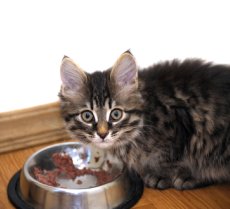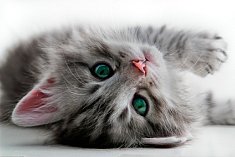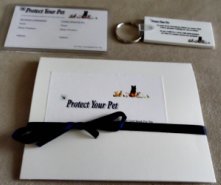Cat Food Allergies: Symptoms, Diagnosis And Treatments

Cat food allergies can be puzzling for the majority of cat owners, one day your cat is enjoying a bowl of scrumptious beef soft food, eating and licking their lips, and the next your feline friend is excessively scratching and has red lesions on their skin.
Cat food allergies do not simply occur from new food or treats that you may give your cat, but in fact they usually develop from the ingredients in the food or cat treats that your cat has been enjoying for years.
Symptoms
At first a cat food allergy can present itself as fleas, due to your cats consistent itching, so it's important to take your cat to the vet to verify that you cat isn't itching because of those pesky fleas. If your cat is diagnosis with fleas read Effective Cat Flea Treatment to find out how to get rid of them.
Cats usually develop food allergies to the ingredients they're exposed to the most, and these allergies may take years to develop. Most cats will eat the same food for years without any sign of an allergy. Cat food allergy is most often seen in cat's between the ages of 2 to 6 years old. The most common cat food allergies include wheat gluten, soy, beef, lamb, seafood, corn and dairy products.
Symptoms of cat food allergies include excessive itching, particularly on the front part of the body including the face and ears. Other symptoms can include excessive licking or chewing on the paws, legs or tummy, red or itchy ears, hair loss, recurrent ear infections, and small red or crusty lesions on the skin are also common. Less common symptoms include vomiting and diarrhea. If you suspect your feline friend has a food allergy, take him or her to the veterinarian as soon as possible. Only a vet can make a proper diagnosis. Be sure to note when your cat last ate and the specific type of food that was eaten.
Diagnosis
In order to diagnose a cat food allergy, your vet will usually first check for flea bites, skin diseases, intestinal parasites, and other cat health problems, so that they can rule out any other causes for the symptoms your cat may be experiencing. The vet may perform blood or skin tests to ensure it is a cat food allergy.
Diagnosing food allergy can be tricky, and sometimes vets may begin treatment without having an official diagnosis. If the treatment proves to be effective and gets rid of the symptoms then a diagnosis may be confirmed.
Treatments
Your vet may begin by placing your cat on a special hypoallergenic diet for eight to 12 weeks, if the symptoms disappear, then your vet may advise that your cat stays on that diet to prevent the symptoms from returning. Although these specially formulated foods can be expensive they may help to reduce and even eliminate your cats allergic reactions. These type of food are usually made with several simple ingredients to reduce your cats chances of having a reaction.
Your vet may also recommended a trial-and-error diet,where you stop feeding your cat foods that they have been regularly eating prior to their allergic reactions. You then begin to slowly reintroducing certain foods, with your vet's guidance, meanwhile paying close attention to any foods that trigger an allergic reaction. Keeping a food diary or log will be required and plays a helpful role in keeping track. Keep in mind that any treats you give your cat must also have the same or similar ingredients as the current food you are using in the trial.
Although Steroids has been used as a treatment method, we do not recommend it. Steroids has several health risks such as; it makes your cat more susceptible to infections since it suppress their immune system. Therefore cats receiving steroid treatment should not be vaccinated because the shots don't allow the immune system to react to the vaccine.
Immunotherapy, is another treatment used for cat food allergies. Although it is not a common treatment, in some cases it has been successfully used to eliminate cat food allergies. In order to implement this treatment, your veterinarian wouldfirst need to pinpoint the exact ingredient/ingredients causing the allergic reaction. The allergen is then diluted and given as a vaccine to your cat, to help build up an immunity to it. The vaccine, as all vaccines are created to do, then signals the cat's immune system to stop trying to fight off the ingredient. If your cat's body puts up a white flag of peace and stops fighting the ingredient, your cat can then start comfortable eating it again. Your vet will want you to feed your cat a small amount of the ingredient to see if there is a negative reaction. Immunotherapy is rarely used in cats and requires a long term commitment.
Another option for treatment could be making your own homemade cat food, leaving the allergen out of the cat's diet. Here are some of our homemade recipes that our cats love Homemade Cat Food Recipes.
Even with a homemade diet you will need to place close attention to how your cat reacts to the food your feeding them, and slowly introduce an ingredient into your cat's diet and watch over a couple of weeks how they react to the new ingredient. It is also important to remember that your cat's regular food offers them certain vitamin and nutrients that keeps them healthy, like taurine, an omino acid that your cat's body does not produce, so your cat will need a balance homemade diet that includes vitamins. Also keep in mind when preparing homemade meals that their are some human foods such as onions and garlic that are toxic to cats.
What if Treatment Wasn't Successful?
If your cat shows no improvement even after being placed on a hypoallergenic diet , it's possible the problem maybe an inhalant and not a cat food allergy. Your vet will work with you to find out what allergy your cat may have. Other common allergens posing a threat to cats include cigarette smoke, perfumes, tree pollen, grass, weeds, mold, mildew, dust pollen, and certain cleaning products,
Similar Topics
How To Choose The Best Cat Food For Your Feline Friend - A Detailed Look At One Of The Most Important Aspects Of Your Cat's Health, Your Cat's Food.
Cat Feeding Bowls: Which Ones Are Safe For Your Cat? - An Examination Of the Different Types Of Cat Bowls And Which Ones Are The Safest.
How To Choose The Healthiest Dry Cat Food- A List Of Important Factors To Keep In Mind When Buying Your Next Bag Of Cat Food.
Feline Acne: Causes, Symptoms,Treatments - Feline acne is much more common than most cat owners realize. Read to find out the causes, symptoms to be aware of and effective treatment options.
Feline Skin Problems: Causes And Effective Treatments - Feline skin problems can be both irritating and very uncomfortable for your cat. Read to find out symptoms to be aware of and effective treatment options.
Feline Hair Loss: Causes, And Different Treatment Options - This article discusses the many different causes and effective treatment options for feline hair loss.
Feline Constipation: Causes, Symptoms And Treatment Options -Feline constipation can be both uncomfortable and painful for your cats, read to find out causes, symptoms and different treatment options.
Return From Cat Food Allergies To Cat Health Home Page
Protect Your Pet Card
In Case Of An Emergency The Protect Your Pet Card Lets Emergency Services Know That You Have Pet/Pets Waiting For You At Home, Making Sure That Your Pets Are Cared For.
Get Your Card Today!
Win A Free $250 Petsmart Gift Card For Your Cat!
Must Be A US Resident
Click Here To Easily Enter For Your Chance To Win.

Is The Cat Food Your Feeding Your Cat Safe And Healthy? Has It Had Any Recent Recalls?
The Petsumer Report provides you with all the information you need to know about the food your feeding your feline friend.
"There are few things in life more heartwarming than to be welcomed by a cat."






